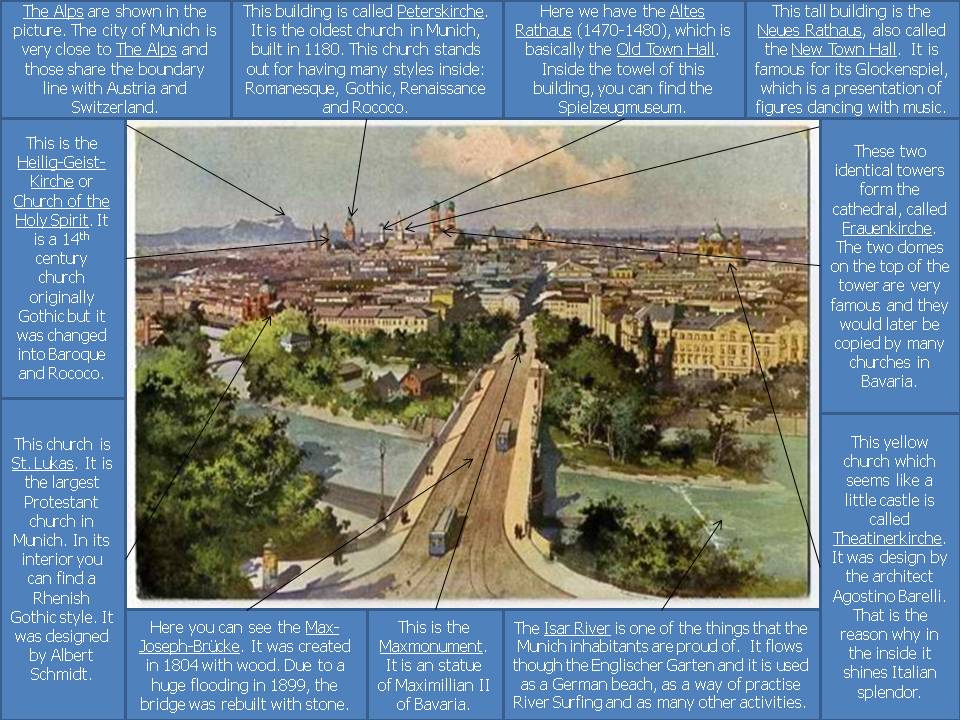The city I have chosen is Munich. I took the image from a vintage postcard dated in the late 19th Century and it is an aquarelle that shows the Max-Joseph-Brücke and at the back of the painting there is a panoramic view of the main monuments of the city centre. In the image we can also appreciate the Alps, the Isar River and the Englischer Garten. The name of the person who painted this image is unknown. The main street in the photo is called Maximillianstraße and the neighbourhood is the Innenstadt Nord. If we compare the painting with the current view in Google Maps, we can see that times goes by.
The landscape around Munich is similar to other cities in Central Europe. The Alps mountain range is very close to Munich and this makes the climate quite cold in winter. It snows for about 4 to 5 months every year. There is also a weird phenomenon from The Alps called föhn, which is basically a wind that can come up in any season and brings shine and clear skies. Another geographical feature is the Isar River, which cross Munich. It is the fourth largest river in Bavaria. We can observe that the river is dividing the city into two parts. In the west side we find the Old Town. Its buildings were built during the first half of 18th Century in Baroque and Rococo style. Marienplatz is the main square of the city, known before as Schrannenmarkt (the marketplace). In the place we can also find the Neues Rathaus (19th Century). It is famous because of its carillon, the Glockenspielt. On the other side of the river we can find the modern part of the city. In this area there is a mixture between leisure buildings, gardens, baths, breweries, residences and houses. The city was Olympic Venue in 1972. As a result of this, there is a famous park in the outside of the city called Olympiapark.
During the middle ages, the centre of the city was surrounded by a city wall. Nowadays we still can see the four main city gates called Sendlinger Tor, Isartor, Schwabinger Tor and Karlstor. Firstly, the city was developed alongside the River Isar. Lately it presented a radio centric plan, which was well organized. From this nucleus the city start to grow and now it is composed by different neighbourhoods. The most important ones are Ludwigsvorstadt, Sendling, Giesing, Ramersdorf, Haidhausen, Bogenhausen, Schwabing and Maxvorstadt. They have a good network of subways that connect all of them and bike paths all around the city.
Munich is a city full of parks, palaces, museums, art galleries and his famous Theatre and Opera house. The inhabitants keep their old traditions. They use to dressing in ancient Lederhosen and Dirndl not only in the Oktoberfest but also when going to church every Sunday. There are many beer breweries in the city because the population love beer. The most famous tavern in the world is the Hofbräuhaus, which was inaugurated by the king William V in 1589. In this brewery you can also enjoy the traditional music of the Bavarian region and the typical Bavarian gastronomy such as sausages, knuckle of pork, crucrut and apflestrudel.
In the 19th Century the population of Munich was around 831,000 inhabitants. Nowadays the metropolitan city has 1, 34 million inhabitants and 300,000 of those are immigrants (Turkish, Albanians, Croats, Serbs, Greeks, Austrians and Italians among others). There are different social classes. The rich population live in little towns and residential areas around the city. The rest live in working-class neighbourhoods. Munich is mainly an industrial city. It holds very important companies like BMW, IBM, Alliance, etc. and is also one of the cores of the publishing industry.
The current image of the buildings in the city centre is due to a fantastic rebuilt after the Second World War because Munich was almost completely destroyed. Today it is the capital of the free state of Bavaria and has two important international authorities, which are the Federal Finance Court of Germany and the European Patent Office. Historically, Munich is also related with Adolf Hitler because here he began his assault to power, bursting into a meeting in the Bürberbräukeller.


